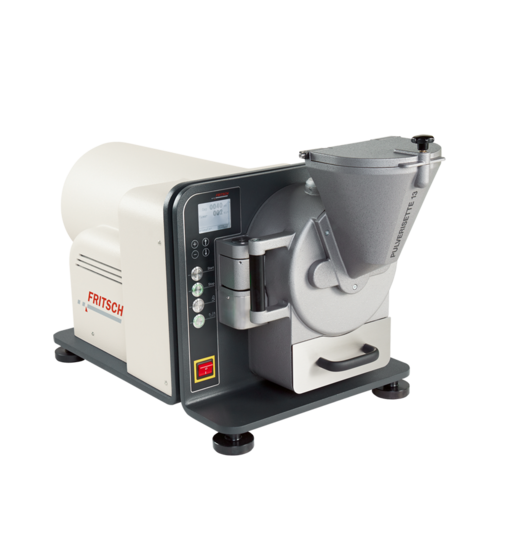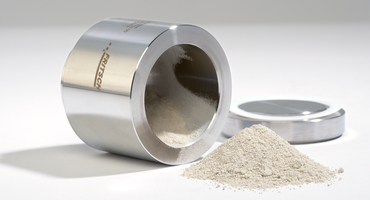Divers Broyeurs à rotor / à marteaux
AUTRES GROUPES DE PRODUITS
Broyeur à marteaux - Insert de broyage en fonte
PULVERISETTE 16
Le broyeur à marteaux PULVERISETTE 16 est fourni avec un insert de broyage et un croisillon à marteaux en fonte et des plaques d'impact en acier trempé, ainsi qu'avec un récipient collecteur de 5 l et une manche filtrante.
Des tamis de fond en acier inoxydable de différentes tailles et à perforations diverses sont disponibles comptent parmi les accessoires, tout comme un récipient collecteur spécial de 30 l et une manche filtrante.
Visualiser données matériau pour insert de broyage, croisillon à marteaux et des plaques d'impact
Veuillez tenir compte des points suivants : Chaque broyeur FRITSCH exige au moins un tamis de fond en supplément.
TAMIS DE FOND EN ACIER INOXYDABLE 316L

Des tamis de fond en acier inoxydable sont disponibles pour PULVERISETTE 16, avec des perforations rondes ou trapézoïdales et de différentes tailles. Le principe suivant s'applique : plus le résultat souhaité est fin, plus les perforations du tamis de fond doivent être petites. Plus les perforations sont grandes, plus le débit est important.
TAMIS DE FOND EN ACIER INOXYDABLE 316L

The bottom sieves are made of stainless steel trapezoidal resp. round perforation sheets of metal. Larger openings mean faster throughput, less time in the mill and less wear.
Bottom sieves with trapezoidal perforation offer an improved size reduction through extra shearing action. Bottom sieves with round perforation are recommended for size reduction of brittle material of medium fineness with smaller grain width band.
| General specifications | |
| Material | Stainless steel – 1.4404/316L |
| ISO/EN/DIN code | X2CrNiMo17-12-2 |
| Chemical composition | |
| Element | Share % |
| Iron – Fe | approx. 62.8 |
| Carbon – C | 0.03 |
| Silicon – Si | 1 |
| Manganese – Mn | 2 |
| Phosphorus – P | 0.045 |
| Sulphur – S | 0.015 |
| Chromium – Cr | 18.5 |
| Molybdenum – Mo | 2.50 |
| Nickel – Ni | 13.00 |
| Nitrogen – N | 0.110 |
| Physical and mechanical properties | |
| Density | 8.0 g/cm³ |
| Hardness | 215 HB |
Explanations on hardness data

The bottom sieves are made of stainless steel trapezoidal resp. round perforation sheets of metal. Larger openings mean faster throughput, less time in the mill and less wear.
Bottom sieves with trapezoidal perforation offer an improved size reduction through extra shearing action. Bottom sieves with round perforation are recommended for size reduction of brittle material of medium fineness with smaller grain width band.
| General specifications | |
| Material | Stainless steel – 1.4404/316L |
| ISO/EN/DIN code | X2CrNiMo17-12-2 |
| Chemical composition | |
| Element | Share % |
| Iron – Fe | approx. 62.8 |
| Carbon – C | 0.03 |
| Silicon – Si | 1 |
| Manganese – Mn | 2 |
| Phosphorus – P | 0.045 |
| Sulphur – S | 0.015 |
| Chromium – Cr | 18.5 |
| Molybdenum – Mo | 2.50 |
| Nickel – Ni | 13.00 |
| Nitrogen – N | 0.110 |
| Physical and mechanical properties | |
| Density | 8.0 g/cm³ |
| Hardness | 215 HB |
Explanations on hardness data

The bottom sieves are made of stainless steel trapezoidal resp. round perforation sheets of metal. Larger openings mean faster throughput, less time in the mill and less wear.
Bottom sieves with trapezoidal perforation offer an improved size reduction through extra shearing action. Bottom sieves with round perforation are recommended for size reduction of brittle material of medium fineness with smaller grain width band.
| General specifications | |
| Material | Stainless steel – 1.4404/316L |
| ISO/EN/DIN code | X2CrNiMo17-12-2 |
| Chemical composition | |
| Element | Share % |
| Iron – Fe | approx. 62.8 |
| Carbon – C | 0.03 |
| Silicon – Si | 1 |
| Manganese – Mn | 2 |
| Phosphorus – P | 0.045 |
| Sulphur – S | 0.015 |
| Chromium – Cr | 18.5 |
| Molybdenum – Mo | 2.50 |
| Nickel – Ni | 13.00 |
| Nitrogen – N | 0.110 |
| Physical and mechanical properties | |
| Density | 8.0 g/cm³ |
| Hardness | 215 HB |
Explanations on hardness data

The bottom sieves are made of stainless steel trapezoidal resp. round perforation sheets of metal. Larger openings mean faster throughput, less time in the mill and less wear.
Bottom sieves with trapezoidal perforation offer an improved size reduction through extra shearing action. Bottom sieves with round perforation are recommended for size reduction of brittle material of medium fineness with smaller grain width band.
| General specifications | |
| Material | Stainless steel – 1.4404/316L |
| ISO/EN/DIN code | X2CrNiMo17-12-2 |
| Chemical composition | |
| Element | Share % |
| Iron – Fe | approx. 62.8 |
| Carbon – C | 0.03 |
| Silicon – Si | 1 |
| Manganese – Mn | 2 |
| Phosphorus – P | 0.045 |
| Sulphur – S | 0.015 |
| Chromium – Cr | 18.5 |
| Molybdenum – Mo | 2.50 |
| Nickel – Ni | 13.00 |
| Nitrogen – N | 0.110 |
| Physical and mechanical properties | |
| Density | 8.0 g/cm³ |
| Hardness | 215 HB |
Explanations on hardness data

The bottom sieves are made of stainless steel trapezoidal resp. round perforation sheets of metal. Larger openings mean faster throughput, less time in the mill and less wear.
Bottom sieves with trapezoidal perforation offer an improved size reduction through extra shearing action. Bottom sieves with round perforation are recommended for size reduction of brittle material of medium fineness with smaller grain width band.
| General specifications | |
| Material | Stainless steel – 1.4404/316L |
| ISO/EN/DIN code | X2CrNiMo17-12-2 |
| Chemical composition | |
| Element | Share % |
| Iron – Fe | approx. 62.8 |
| Carbon – C | 0.03 |
| Silicon – Si | 1 |
| Manganese – Mn | 2 |
| Phosphorus – P | 0.045 |
| Sulphur – S | 0.015 |
| Chromium – Cr | 18.5 |
| Molybdenum – Mo | 2.50 |
| Nickel – Ni | 13.00 |
| Nitrogen – N | 0.110 |
| Physical and mechanical properties | |
| Density | 8.0 g/cm³ |
| Hardness | 215 HB |
Explanations on hardness data

The bottom sieves are made of stainless steel trapezoidal resp. round perforation sheets of metal. Larger openings mean faster throughput, less time in the mill and less wear.
Bottom sieves with trapezoidal perforation offer an improved size reduction through extra shearing action. Bottom sieves with round perforation are recommended for size reduction of brittle material of medium fineness with smaller grain width band.
| General specifications | |
| Material | Stainless steel – 1.4404/316L |
| ISO/EN/DIN code | X2CrNiMo17-12-2 |
| Chemical composition | |
| Element | Share % |
| Iron – Fe | approx. 62.8 |
| Carbon – C | 0.03 |
| Silicon – Si | 1 |
| Manganese – Mn | 2 |
| Phosphorus – P | 0.045 |
| Sulphur – S | 0.015 |
| Chromium – Cr | 18.5 |
| Molybdenum – Mo | 2.50 |
| Nickel – Ni | 13.00 |
| Nitrogen – N | 0.110 |
| Physical and mechanical properties | |
| Density | 8.0 g/cm³ |
| Hardness | 215 HB |
Explanations on hardness data

The bottom sieves are made of stainless steel trapezoidal resp. round perforation sheets of metal. Larger openings mean faster throughput, less time in the mill and less wear.
Bottom sieves with trapezoidal perforation offer an improved size reduction through extra shearing action. Bottom sieves with round perforation are recommended for size reduction of brittle material of medium fineness with smaller grain width band.
| General specifications | |
| Material | Stainless steel – 1.4404/316L |
| ISO/EN/DIN code | X2CrNiMo17-12-2 |
| Chemical composition | |
| Element | Share % |
| Iron – Fe | approx. 62.8 |
| Carbon – C | 0.03 |
| Silicon – Si | 1 |
| Manganese – Mn | 2 |
| Phosphorus – P | 0.045 |
| Sulphur – S | 0.015 |
| Chromium – Cr | 18.5 |
| Molybdenum – Mo | 2.50 |
| Nickel – Ni | 13.00 |
| Nitrogen – N | 0.110 |
| Physical and mechanical properties | |
| Density | 8.0 g/cm³ |
| Hardness | 215 HB |
Explanations on hardness data

The bottom sieves are made of stainless steel trapezoidal resp. round perforation sheets of metal. Larger openings mean faster throughput, less time in the mill and less wear.
Bottom sieves with trapezoidal perforation offer an improved size reduction through extra shearing action. Bottom sieves with round perforation are recommended for size reduction of brittle material of medium fineness with smaller grain width band.
| General specifications | |
| Material | Stainless steel – 1.4404/316L |
| ISO/EN/DIN code | X2CrNiMo17-12-2 |
| Chemical composition | |
| Element | Share % |
| Iron – Fe | approx. 62.8 |
| Carbon – C | 0.03 |
| Silicon – Si | 1 |
| Manganese – Mn | 2 |
| Phosphorus – P | 0.045 |
| Sulphur – S | 0.015 |
| Chromium – Cr | 18.5 |
| Molybdenum – Mo | 2.50 |
| Nickel – Ni | 13.00 |
| Nitrogen – N | 0.110 |
| Physical and mechanical properties | |
| Density | 8.0 g/cm³ |
| Hardness | 215 HB |
Explanations on hardness data

The bottom sieves are made of stainless steel trapezoidal resp. round perforation sheets of metal. Larger openings mean faster throughput, less time in the mill and less wear.
Bottom sieves with trapezoidal perforation offer an improved size reduction through extra shearing action. Bottom sieves with round perforation are recommended for size reduction of brittle material of medium fineness with smaller grain width band.
| General specifications | |
| Material | Stainless steel – 1.4404/316L |
| ISO/EN/DIN code | X2CrNiMo17-12-2 |
| Chemical composition | |
| Element | Share % |
| Iron – Fe | approx. 62.8 |
| Carbon – C | 0.03 |
| Silicon – Si | 1 |
| Manganese – Mn | 2 |
| Phosphorus – P | 0.045 |
| Sulphur – S | 0.015 |
| Chromium – Cr | 18.5 |
| Molybdenum – Mo | 2.50 |
| Nickel – Ni | 13.00 |
| Nitrogen – N | 0.110 |
| Physical and mechanical properties | |
| Density | 8.0 g/cm³ |
| Hardness | 215 HB |
Explanations on hardness data

The bottom sieves are made of stainless steel trapezoidal resp. round perforation sheets of metal. Larger openings mean faster throughput, less time in the mill and less wear.
Bottom sieves with trapezoidal perforation offer an improved size reduction through extra shearing action. Bottom sieves with round perforation are recommended for size reduction of brittle material of medium fineness with smaller grain width band.
| General specifications | |
| Material | Stainless steel – 1.4404/316L |
| ISO/EN/DIN code | X2CrNiMo17-12-2 |
| Chemical composition | |
| Element | Share % |
| Iron – Fe | approx. 62.8 |
| Carbon – C | 0.03 |
| Silicon – Si | 1 |
| Manganese – Mn | 2 |
| Phosphorus – P | 0.045 |
| Sulphur – S | 0.015 |
| Chromium – Cr | 18.5 |
| Molybdenum – Mo | 2.50 |
| Nickel – Ni | 13.00 |
| Nitrogen – N | 0.110 |
| Physical and mechanical properties | |
| Density | 8.0 g/cm³ |
| Hardness | 215 HB |
Explanations on hardness data

The bottom sieves are made of stainless steel trapezoidal resp. round perforation sheets metal. Larger openings mean faster throughput, less time in the mill and less wear.
Bottom sieves with trapezoidal perforation offer an improved size reduction through extra shearing action. Bottom sieves with round perforation are recommended for size reduction of brittle material of medium fineness with smaller grain width band.
| General specifications | |
| Material | Stainless steel – 1.4404/316L |
| ISO/EN/DIN code | X2CrNiMo17-12-2 |
| Chemical composition | |
| Element | Share % |
| Iron – Fe | approx. 62.8 |
| Carbon – C | 0.03 |
| Silicon – Si | 1 |
| Manganese – Mn | 2 |
| Phosphorus – P | 0.045 |
| Sulphur – S | 0.015 |
| Chromium – Cr | 18.5 |
| Molybdenum – Mo | 2.50 |
| Nickel – Ni | 13.00 |
| Nitrogen – N | 0.110 |
| Physical and mechanical properties | |
| Density | 8.0 g/cm³ |
| Hardness | 215 HB |
Explanations on hardness data

The bottom sieves are made of stainless steel trapezoidal resp. round perforation sheets of metal. Larger openings mean faster throughput, less time in the mill and less wear.
Bottom sieves with trapezoidal perforation offer an improved size reduction through extra shearing action. Bottom sieves with round perforation are recommended for size reduction of brittle material of medium fineness with smaller grain width band.
| General specifications | |
| Material | Stainless steel – 1.4404/316L |
| ISO/EN/DIN code | X2CrNiMo17-12-2 |
| Chemical composition | |
| Element | Share % |
| Iron – Fe | approx. 62.8 |
| Carbon – C | 0.03 |
| Silicon – Si | 1 |
| Manganese – Mn | 2 |
| Phosphorus – P | 0.045 |
| Sulphur – S | 0.015 |
| Chromium – Cr | 18.5 |
| Molybdenum – Mo | 2.50 |
| Nickel – Ni | 13.00 |
| Nitrogen – N | 0.110 |
| Physical and mechanical properties | |
| Density | 8.0 g/cm³ |
| Hardness | 215 HB |
Explanations on hardness data

The bottom sieves are made of stainless steel trapezoidal resp. round perforation sheets of metal. Larger openings mean faster throughput, less time in the mill and less wear.
Bottom sieves with trapezoidal perforation offer an improved size reduction through extra shearing action. Bottom sieves with round perforation are recommended for size reduction of brittle material of medium fineness with smaller grain width band.
| General specifications | |
| Material | Stainless steel – 1.4404/316L |
| ISO/EN/DIN code | X2CrNiMo17-12-2 |
| Chemical composition | |
| Element | Share % |
| Iron – Fe | approx. 62.8 |
| Carbon – C | 0.03 |
| Silicon – Si | 1 |
| Manganese – Mn | 2 |
| Phosphorus – P | 0.045 |
| Sulphur – S | 0.015 |
| Chromium – Cr | 18.5 |
| Molybdenum – Mo | 2.50 |
| Nickel – Ni | 13.00 |
| Nitrogen – N | 0.110 |
| Physical and mechanical properties | |
| Density | 8.0 g/cm³ |
| Hardness | 215 HB |
Explanations on hardness data

The bottom sieves are made of stainless steel trapezoidal resp. round perforation sheets of metal. Larger openings mean faster throughput, less time in the mill and less wear.
Bottom sieves with trapezoidal perforation offer an improved size reduction through extra shearing action. Bottom sieves with round perforation are recommended for size reduction of brittle material of medium fineness with smaller grain width band.
| General specifications | |
| Material | Stainless steel – 1.4404/316L |
| ISO/EN/DIN code | X2CrNiMo17-12-2 |
| Chemical composition | |
| Element | Share % |
| Iron – Fe | approx. 62.8 |
| Carbon – C | 0.03 |
| Silicon – Si | 1 |
| Manganese – Mn | 2 |
| Phosphorus – P | 0.045 |
| Sulphur – S | 0.015 |
| Chromium – Cr | 18.5 |
| Molybdenum – Mo | 2.50 |
| Nickel – Ni | 13.00 |
| Nitrogen – N | 0.110 |
| Physical and mechanical properties | |
| Density | 8.0 g/cm³ |
| Hardness | 215 HB |
Explanations on hardness data

The bottom sieves are made of stainless steel trapezoidal resp. round perforation sheets of metal. Larger openings mean faster throughput, less time in the mill and less wear.
Bottom sieves with trapezoidal perforation offer an improved size reduction through extra shearing action. Bottom sieves with round perforation are recommended for size reduction of brittle material of medium fineness with smaller grain width band.
| General specifications | |
| Material | Stainless steel – 1.4404/316L |
| ISO/EN/DIN code | X2CrNiMo17-12-2 |
| Chemical composition | |
| Element | Share % |
| Iron – Fe | approx. 62.8 |
| Carbon – C | 0.03 |
| Silicon – Si | 1 |
| Manganese – Mn | 2 |
| Phosphorus – P | 0.045 |
| Sulphur – S | 0.015 |
| Chromium – Cr | 18.5 |
| Molybdenum – Mo | 2.50 |
| Nickel – Ni | 13.00 |
| Nitrogen – N | 0.110 |
| Physical and mechanical properties | |
| Density | 8.0 g/cm³ |
| Hardness | 215 HB |
Explanations on hardness data
Tamis de fond en acier sans chrome DC01Cu pour le broyage sans métaux lourds

The bottom sieves are made of chromium-free steel DC01Cu trapezoidal resp. round perforation sheets of metal. Larger openings mean faster throughput, less time in the mill and less wear.
Bottom sieves with trapezoidal perforation offer an improved size reduction through extra shearing action. Bottom sieves with round perforation are recommended for size reduction of brittle material of medium fineness with smaller grain width band.

The bottom sieves are made of chromium-free steel DC01Cu trapezoidal resp. round perforation sheets of metal. Larger openings mean faster throughput, less time in the mill and less wear.
Bottom sieves with trapezoidal perforation offer an improved size reduction through extra shearing action. Bottom sieves with round perforation are recommended for size reduction of brittle material of medium fineness with smaller grain width band.

The bottom sieves are made of chromium-free steel DC01Cu trapezoidal resp. round perforation sheets of metal. Larger openings mean faster throughput, less time in the mill and less wear.
Bottom sieves with trapezoidal perforation offer an improved size reduction through extra shearing action. Bottom sieves with round perforation are recommended for size reduction of brittle material of medium fineness with smaller grain width band.
Dispositif d‘aspiration d‘échantillon avec cyclone
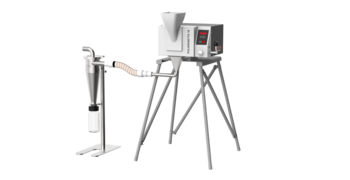
La combinaison du broyeur à marteaux avec le séparateur Cyclone haute performance permet un nettoyage et une alimentation simples, l'utilisation de tamis inférieurs plus fins pour obtenir une finesse finale plus élevée, augmente le débit et réduit la charge thermique des échantillons - même pour les matériaux qui sont autrement difficiles à broyer. Sélectionnez Séparateur cyclone et accessoires.
Cyclone haute performance
The FRITSCH high-performance Cyclone separator completely made of stainless steel 316L is indispensable in many industries. Due to its high surface quality, it offers enhanced resistance to corrosive media such as alkalis and acids and is especially easy to clean with a wide range of possible cleaning agents, without leaving any residues. The comminuted sample is drawn into a screwed-on collecting vessel or in a smaller sample glass, in which it can also be transported and stored. In addition, it can be completely dismantled, fully emptied, flooded and sterilised, and thus offers reliable protection against cross-contamination.
The advantages of the high-performance Cyclone separator at a glance
- Faster throughput
- Improved discharge of material from the grinding chamber
- Additional strong cooling of the grinding material and grinding parts
- Efficient size reduction of temperature-sensitive samples, electrostatically-charged plastics or powder coatings
- Ideal for light materials, small sample quantities and finer sieve sizes
- Highly efficient continuous comminution of large quantities
| General specifications | |
| Material | Stainless steel – 1.4301 |
| ISO/EN/DIN code | X5CrNi1810 |
| Chemical composition | |
| Element | Share % |
| Iron – Fe | 66.805 |
| Carbon – C | 0.070 |
| Silicon – Si | 1.000 |
| Manganese – Mn | 2.000 |
| Phosphorus – P | 0.045 |
| Sulphur – S | 0.030 |
| Chromium – Cr | 19.5 |
| Nickel – Ni | 10.5 |
| Nitrogen – N | 0.110 |
| Physical and mechanical properties | |
| Density | 7.8 g/cm³ |
| Hardness | HRB 96 |
Explanations on hardness data
Récipients collecteurs pour cyclone haute performance
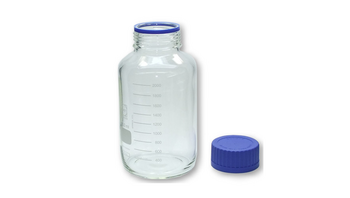
Sample glass 1 litre for sample exhaustion with the high-performance Cyclone separator.

The sample glass with 2 litres volume is recommended for sample exhaustion with the high-performance Cyclone separator for sample discharges larger than 1000 ml, since only a 1 litre sample glass is included in the delivery of the high-performance Cyclone separator.

The sample glass with 5 litres volume is recommended for sample exhaustion with the high-performance Cyclone separator for sample discharges larger than 1000 ml, since only a 1 litre sample glass is included in the delivery of the high-performance Cyclone separator.
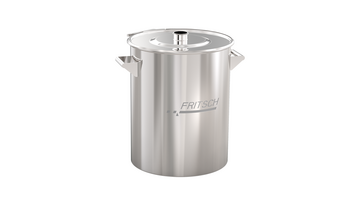
The collecting vessel 20 litres is recommended for sample exhaustion with the high-performance Cyclone separator for sample discharges larger than 1000 ml, since only a 1 litre sample glass is included in the delivery of the high-performance Cyclone separator.
| General specifications | |
| Material | Stainless steel – 1.4404/316L |
| ISO/EN/DIN code | X2CrNiMo17-12-2 |
| Chemical composition | |
| Element | Share % |
| Iron – Fe | approx. 62.8 |
| Carbon – C | 0.03 |
| Silicon – Si | 1 |
| Manganese – Mn | 2 |
| Phosphorus – P | 0.045 |
| Sulphur – S | 0.015 |
| Chromium – Cr | 18.5 |
| Molybdenum – Mo | 2.50 |
| Nickel – Ni | 13.00 |
| Nitrogen – N | 0.110 |
| Physical and mechanical properties | |
| Density | 8.0 g/cm³ |
| Hardness | 215 HB |
Explanations on hardness data

The collecting vessel 60 litres is recommended for sample exhaustion with the high-performance Cyclone separator for sample discharges larger than 1000 ml, since only a 1 litre sample glass is included in the delivery of the high-performance Cyclone separator.
| General specifications | |
| Material | Stainless steel – 1.4404/316L |
| ISO/EN/DIN code | X2CrNiMo17-12-2 |
| Chemical composition | |
| Element | Share % |
| Iron – Fe | approx. 62.8 |
| Carbon – C | 0.03 |
| Silicon – Si | 1 |
| Manganese – Mn | 2 |
| Phosphorus – P | 0.045 |
| Sulphur – S | 0.015 |
| Chromium – Cr | 18.5 |
| Molybdenum – Mo | 2.50 |
| Nickel – Ni | 13.00 |
| Nitrogen – N | 0.110 |
| Physical and mechanical properties | |
| Density | 8.0 g/cm³ |
| Hardness | 215 HB |
Explanations on hardness data
Système d’aspiration pour le cyclone haute performance
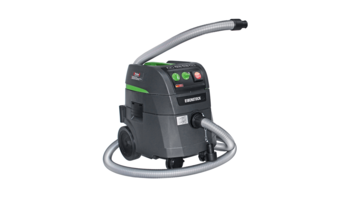
The exhaust system, dust category "M" according to DIN EN 60335-2-69 for 230 V/1~, 50/60 Hz, 1600 Watt is versatile:
For combination with the high performance and small volume cyclones.
To operate the FRITSCH Cyclones you need an exhaust system. The strong airflow ensures simple feeding, increases throughput, and reduces the thermal load of the samples. The high performance and small volume Cyclone separator can be combined with Universal Cutting Mills PULVERISETTE 19, the Variable Speed Rotor Mill PULVERISETTE 14 premium line and classic line. The small volume cyclone can also be combined with the Variable Speed Rotor Mill PULVERISETE 14 premium line and classic line even for passive utilisation – without sample exhaust.
The high-performance cyclone is ideal for combination with the Universal Cutting Mills PULVERISETTE 19 large, the Cross Beater Mill PULVERISETTE 16 and the Disk Mill PULVERISETTE 13 premium line for optimal sample extraction and for comminution of larger quantities.
For cooling of the Variable Speed Rotor Mill PULVERISETTE 14 premium line
By connecting the exhaust system with the connecting piece order no. 14.8128.00, the cooling of the mill can easily be enhanced.
For connecting to Disk Mill PULVERISETTE 13 premium line
The exhaust is simply connected to the PULVERISETTE 13 premium line and operated via a start and stop button on the instrument – for dust free comminution.
For connecting to the Jaw Crusher PULVERISETTE 1, Modell I + II classic line
Simply connect the exhaust system to the integrated connection of the PULVERISETTE 1. Fine dust arising during comminution is automatically removed. The exhaust system is also very useful when cleaning the grinding parts.
For connecting to the Disk Mill PULVERISETTE 13 classic line
The exhaust system can be easily connected to the PULVERISETTE 13 classic line. Fine dust arising during comminution is automatically removed. The exhaust system is also very useful when cleaning the grinding parts.
For exhaustion of the sample during dry measurement with the Laser Particle Sizers ANALYSETTE 22 NeXT
An exhaust system is necessary to ensure automatic sample exhaustion during dry measurement. When the measurement is completed it can also be easily used to manually clean the feeder.
Please note that the exhaust system article no. 43.9070.00, is not equipped with a fine filter and therefore dust may escape. Please consider the valid occupational health and safety regulations. This exhaust system is mostly recommended for dust-free grinding and the vacuuming of during the process developing fine dust in the upper part of the grinding chamber and for the cleaning of the grinding parts.
For vacuuming of the sample during dry measurement with the Laser Particle Sizers ANALYSETTE 22 NeXT, we recommended we recommend the exhaust system article no. 43.9060.00, which is equipped with a hose and an ultra-fine filter of dust class "H" according to DIN EN 60335-2-69, so that the escape of fine dust is reduced.
1 pack = 5 pieces
One pack is included in the scope of delivery of the exhaust system (article No. 43.9070.00).
These fleece filter bags should be used for the vacuuming off of fine, dry materials.
For the vacuuming off of coarse, wet materials are plastic bags available (article no. 43.9052.00).
1 pack = 5 pieces
One pack is included in the order of the exhaust system (article No. 43.9070.00).
These plastic bags should be used for the vacuuming off of coarse, wet materials.
For the vacuuming off of fine, dry materials are paper filter bags available (article no. 43.9055.00).
AUTRES ACCESSOIRES

L'équipement standard du PULVERISETTE 16 comprend une manche filtrante située entre le micro-broyeur et le récipient collecteur de 5 litres, qui assure la constance du débit d'air dans la chambre de broyage, accélère le débit et empêche toute retenue – et garantit ainsi que la fragmentation est rapide et préserve le matériau.
Un récipient collecteur de 30 l est également disponible, destiné à la fragmentation de grandes quantités.
Si le PULVERISETTE 16 doit être utilisé en tant qu'appareil sur pied positionnable au choix, il suffit de le combiner avec le support. Un certificat IQ/OQ est également disponible.
Support universel et récipient collecteur
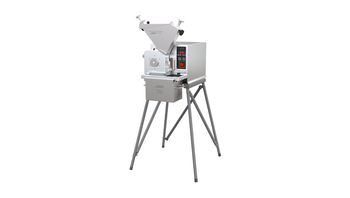
Stand for free installation of the following devices:
Universal Cutting Mill PULVERISETTE 19 variable speed 300-3000 rpm
Universal Cutting Mill PULVERISETTE 19 variable speed 50-700 rpm
Universal Cutting Mill PULVERISETTE 19 variable speed 50-700 rpm large
Universal Cutting Mill PULVERISETTE 19 variable speed 300-3000 rpm Large
Cross Beater Mill PULVERISETTE 16 with grinding insert made of cast iron
Cross Beater Mill PULVERISETTE 16 with grinding insert made of stainless steel
The PULVERISETTE 19 is shown as an example in the photo.
As standard the PULVERISETTE 16 is delivered with a collecting vessel 5 litres. For grinding large quantities this collecting vessel with a capacity of 26 litres and filter hose is recommended.

IQ/OQ documentation (questionnaire format - implementation by customer) for the independent utilization for the support of instrument qualification in the quality management system for the Cross Beater Mill PULVERISETTE 16.





